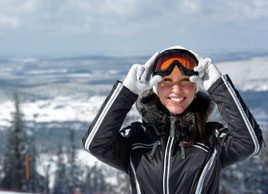How to set your winter fitness goals
Don’t hibernate indoors this winter. Instead, get outside and get fit by participating in winter sports

Source: Web exclusive, November 2009
Don’t let the cold weather keep you indoors this winter. Instead, take up an exciting winter sport that will make staying fit fun. And don’t worry if you’re not about to break a world record’come up with your own, realistic goals and take pride in what you accomplish.
Cross-country skiing and snowshoeing
According to author and personal trainer Michael Carrera, cross-country skiing and snowshoeing each provide a fabulous cardiovascular workout‘and they’re great sports for beginners. ‘These activities are easy to learn, you’re constantly in motion and the low-intensity activity is great for promoting safe and effective workouts.’
Setting goals:
‘ Start with an easy, well-marked path with little or no incline. It might look easy, but you’ll be surprised at how much effort you exert on skis or snowshoes, even on level ground.
‘ On your first time out, go slowly for the first half of your outing, then increase your pace for about twenty minutes before slowing down again at the end of your walk.
‘ Attempt to tackle a new trail that is slightly more difficult each time you go out, but don’t push yourself to the next level if you don’t feel ready. Going faster on a safe, familiar trail can be more beneficial than choosing a tough one and getting lost or exhausted.
Tracking progress:
‘Create a way to track progress that is relevant and motivating for you,’ says Toronto-based doctor of naturopathic medicine and fitness program consultant Andra Campitelli. ‘For some, motivation may come by way of numbers (such as monitoring time, distance, weight loss or body measurements), while for others monitoring feeling of overall wellbeing may be sufficient.’
Skiing, snowboarding and speed skating
Learning these sports requires a certain level of commitment. ‘Never start a winter sport simply as a way of improving your fitness. This often leads to injury, since sports like skiing, snowboarding, and skating are very specific in movement and when someone is unaccustomed to repeating a specific movement at high force or velocity, they can end up hurt,’ Carrera advises.
Setting goals
‘ Carrera recommends preparing yourself for these high-intensity sports by training the entire body and improving strength, stamina and flexibility. ‘A general over all body circuit training program completed three times per week would be fine,’ he says.
‘ Invest in lessons and learn drills and exercises designed to build muscles, increase skill and improve balance. ‘If you’re serious about learning a winter sport, take the time and learn from a pro or from someone who knows the proper technique,’ says Carrera. ‘[Learning] technique and efficiency of movement is half the battle to feeling good, having fun and accomplishing your goals.
Tracking progress
Record the duration of the ski, snowboard or skating workout to gage how much you’re improving. Also, keep track of the number of times you working out every week. ‘Once you’ve decided the best time for an activity, book it off in your schedule,’ says Campitelli. ‘To ensure this time is kept, put it into your BlackBerry, iPhone or day timer. Treat your workout like an important meeting: show up on time and put effort into your actions.’
Winter running
If you’re an avid runner, it’s still possible to maintain your routine in the winter. ‘As long as the ground is dry and it’s not too cold’I wouldn’t recommend running in below-zero weather, especially if there is a strong wind chill, which makes breathing difficult’I think running or jogging outdoors in the winter is great,’ says Carrera.
Setting goals
‘ Your running goals can stay the same from season to season’but you may have to accept that running in the cold takes extra motivation. ‘Find a friend who values activity and healthy living like you do and encourage each other to stay dedicated to your regime,’ suggests Campitelli. ‘Make it social and commit to a schedule together.’ You can also increase your level of motivation by joining a running club.
‘ Adjust your running regime to suit the weather. ‘I spend significantly more time warming up before running in the winter,” says Campitelli. Typically, my warm-up starts indoors with stretching and then continues outside with a brisk walk before running. This ensures my muscles are warm, flexible, and ready to perform. It will also help prevent injuries from stressing a cold muscle or running on uneven snow and ice-covered ground.’
Tracking progress
Create a running plan and record your development. If you’re running on a regular basis, you’ll naturally notice an increase in cardiovascular fitness and ability. Don’t push yourself too hard, but do challenge yourself by tackling more difficult routes or run longer distances. Keep in mind that you may have to change up your plans if the weather doesn’t cooperate. ‘Create a space at home for activity on extremely cold or snow days,’ says Campitelli.
Don’t miss out! Sign up for our free weekly newsletters and get nutritious recipes, healthy weight-loss tips, easy ways to stay in shape and all the health news you need, delivered straight to your inbox.




